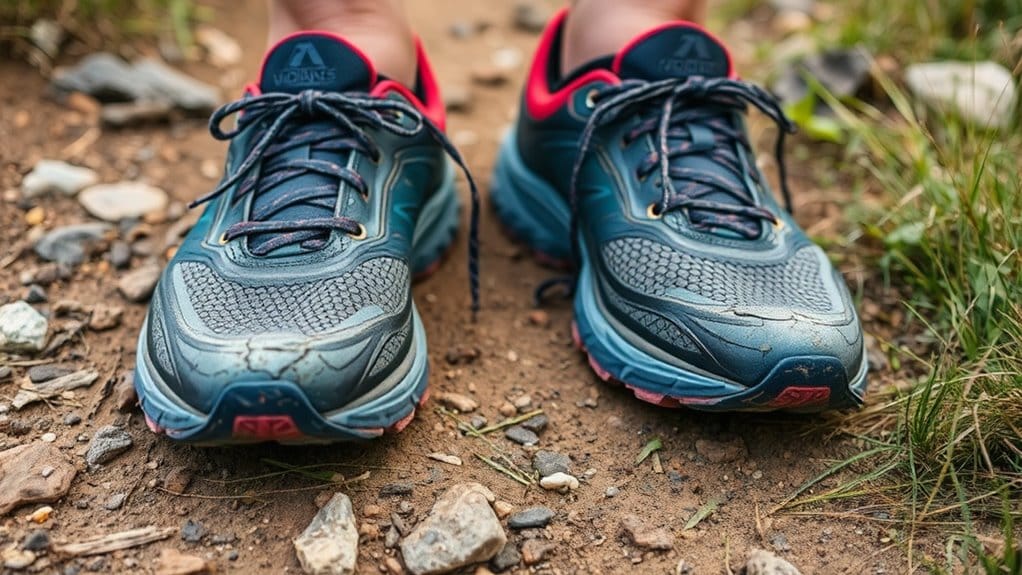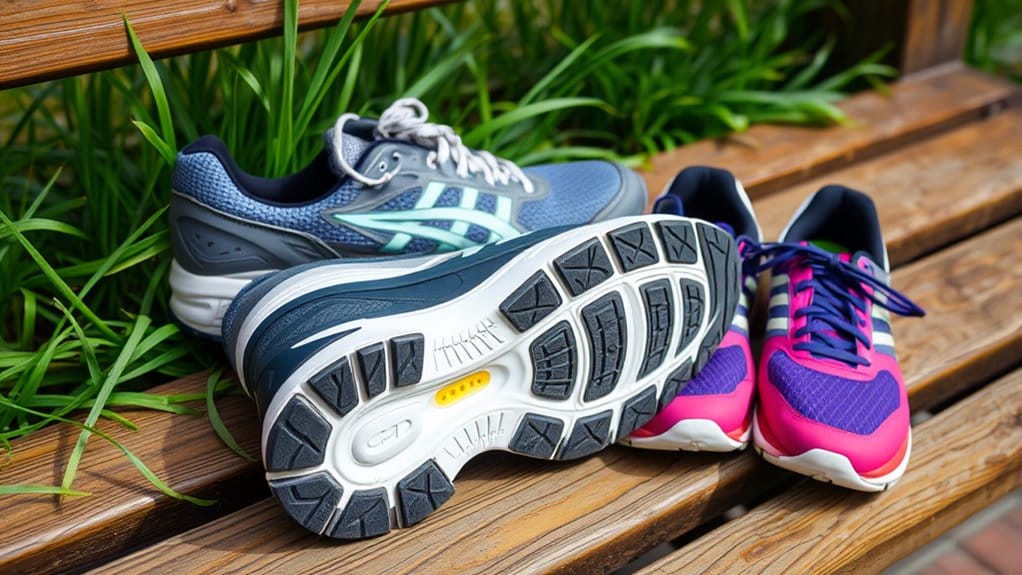This post contains affiliate links. As an Amazon Associate, we earn from qualifying purchases.
You should change your running shoes when you notice discomfort in your feet, legs, or joints, or if the soles show visible wear. Typically, shoes last 300-500 miles, so if you run about 15 miles a week, it’s time for a replacement every 5 to 8 months. Keep an eye on cushioning and check for creases in the midsole. Want to learn more about extending your shoes’ lifespan and selecting the right ones?
Key Takeaways
- Replace running shoes after 300-500 miles, or sooner if you notice discomfort or reduced shock absorption.
- Look for visible signs of wear, such as worn treads or fraying uppers.
- Assess for blisters or hot spots, indicating a poor fit or worn cushioning.
- Check for structural issues like longitudinal creases or a soft midsole that collapses under pressure.
- Consider your running style and surface type, as these can affect shoe longevity and wear patterns.
Signs It’s Time for New Running Shoes
How can you tell when it’s time to retire your running shoes? Look for several clear signs of wear.
If you notice new discomfort in your feet, legs, or joints after running, it’s a strong indication that your shoes need to be replaced. A noticeable reduction in shock absorption, where you feel more impact on your joints, suggests it’s time for a new pair.
Also, keep an eye out for visible signs of wear, like worn treads or fraying uppers. If blisters or hot spots appear unexpectedly, your shoes mightn’t be fitting properly anymore.
Finally, if you’ve clocked 300-500 miles, evaluate your shoes’ condition to prevent running injuries.
Don’t ignore these signs; it’s essential for your performance and comfort.
Mileage Indicators for Shoe Replacement
To keep your running shoes in top shape, it’s essential to track your mileage and watch for signs of wear.
Generally, you’ll want to replace your shoes after 300 to 500 miles, but your weekly distance can affect how long they last.
Regularly checking the outsoles and cushioning can help you stay ahead of any potential injuries.
Mileage Thresholds to Monitor
Monitoring the mileage on your running shoes is essential for maintaining performance and preventing injuries. Typically, running shoes last between 300 to 500 miles, with lightweight options wearing out sooner, around 250 to 300 miles.
If you’re an average runner putting in about 15 miles per week, you’ll want to replace your shoes every 5 to 8 months, depending on your specific wear patterns. It’s important to keep an eye on these mileage thresholds to avoid running in worn-out shoes.
Using GPS or smartphone apps can streamline the monitoring process, ensuring you’re aware of when it’s time to replace your shoes. Remember, even if you haven’t hit those mileage marks, pay attention to any signs of wear.
Signs of Wear
Keeping track of your shoe mileage is just part of the equation when it comes to knowing when to replace your running shoes.
Look for clear signs of wear, like worn shoe soles that expose softer foam underneath. If your midsole feels excessively soft or collapses under pressure, it’s a strong signal to replace your shoes.
Additionally, if you start experiencing discomfort or muscle soreness in your feet, legs, or knees after runs, your shoes may have lost their cushioning and support.
Longitudinal creases in the midsole and a mobile heel counter that lacks structure also indicate it’s time for a change.
Staying aware of these signs will help keep your runs comfortable and injury-free.
Factors Affecting Shoe Longevity

When it comes to your running shoes, the surface you run on and your unique running style can drastically affect their lifespan.
If you often hit the trails with road shoes or have a specific way of landing, you might notice wear and tear sooner than expected.
Understanding these factors helps you make smarter choices about when to replace your shoes.
Running Surface Impact
The surface you run on greatly impacts your shoes’ longevity, as each terrain exerts different levels of wear.
Running shoes designed for roads may deteriorate quickly when used on rocky trails, while softer surfaces like grass can enhance durability.
Harder surfaces, like concrete, increase the impact on your shoes, leading to quicker wear and reduced performance.
If you consistently use shoes on mixed terrains without considering their intended purpose, you risk uneven wear patterns that shorten their lifespan.
To maximize durability, assess your shoes’ features, such as tread patterns and cushioning, ensuring they match your usual running surfaces.
This way, you’ll get the most out of your running shoes and maintain their performance longer.
Individual Running Style
Different running surfaces can wear down your shoes in distinct ways, but your individual running style plays an equally important role in determining how long they last.
Heel striking often leads to quicker wear in the heel, while forefoot striking can damage the area under the big toe. A gait analysis can help identify your running style, allowing you to choose shoes that match your unique wear patterns.
If you’re heavier, expect to replace shoes more often due to increased compression of cushioning materials. Additionally, wearing road shoes on trails can accelerate wear.
Regularly checking for signs of wear specific to your running style helps prevent injuries and guarantees peak performance during your runs.
The Importance of Shoe Rotation
While you might be tempted to stick with a single pair of running shoes, rotating between multiple pairs can greatly enhance your running experience.
Shoe rotation allows your shoes to decompress and recover, which means they’ll last longer. By using two pairs of running shoes designed for different terrains, you can improve performance and comfort, as each shoe tackles specific challenges.
Regularly evaluating the wear on your shoes helps you know when it’s time to replace your running shoes. Plus, having a backup pair for wet or muddy conditions guarantees you stay dry and comfortable.
This approach also reduces your risk of repetitive stress injuries, as different types of shoes provide varied support and cushioning tailored to your needs.
Tips for Extending the Life of Your Running Shoes

Rotating your running shoes is just one way to enhance their lifespan; there are several other strategies to keep them in top shape.
Follow these tips to extend their lifespan and maintain their integrity:
- Limit usage: Use your running shoes exclusively for running to prevent unnecessary mileage and premature wear.
- Clean your shoes: Regularly remove dirt and debris to avoid accelerated wear and tear on materials.
- Store your shoes properly: Keep them in a cool, dry place to prevent damage from moisture and heat.
Understanding Shoe Types and Their Lifespan
Understanding the types of running shoes you wear can greatly impact their lifespan and your overall running experience.
Most running shoes typically last between 300 to 500 miles, but lightweight options might need replacing after just 250 to 300 miles. If you’re a casual runner, expect about 8 to 12 months of use, while those training for half marathons may need new shoes every 4 to 6 months.
The surface type also matters; using road shoes on trails can lead to quicker wear and tear. Additionally, your running style, weight, and shoe quality play significant roles in how long your shoes will last.
Prioritize cushioning and choose the right shoe for your needs to maximize lifespan.
Expert Resources for Shoe Selection and Maintenance

When it comes to finding the right running shoes, tapping into expert resources can make a significant difference in your selection and maintenance process.
By visiting specialty running stores, you can benefit from personalized advice based on your running habits and needs. Here are some key resources to take into account:
- Gait analysis and 3D foot scanning for proper shoe fitting tailored to your biomechanics.
- Regular checks for signs of wear, like fraying or flattened cushioning, to inform your shoe maintenance.
- Guides on shoe lifespan, with recommendations generally between 300 and 500 miles.
Consulting professionals can help you choose the right shoes and maintain them effectively, ensuring you get the best performance and longevity out of your footwear.
Conclusion
In summary, knowing when to change your running shoes is essential for your performance and injury prevention. Keep an eye out for signs like worn soles or discomfort, and track your mileage to guarantee you’re replacing them at the right time. Remember to reflect on factors that affect shoe longevity and the benefits of rotating your footwear. By following these tips and understanding your shoe type, you’ll not only extend their life but also enhance your running experience.

